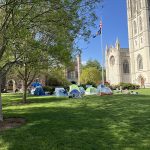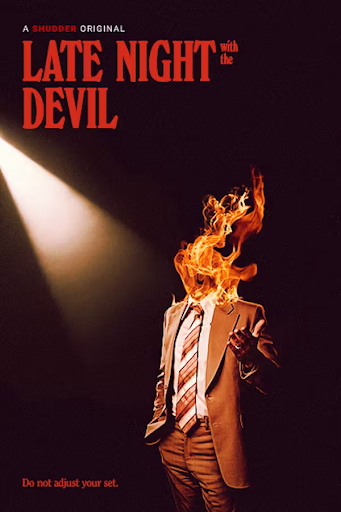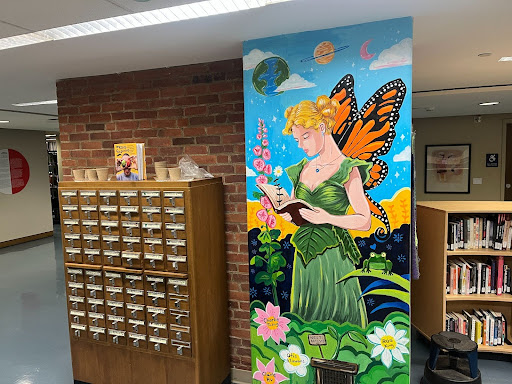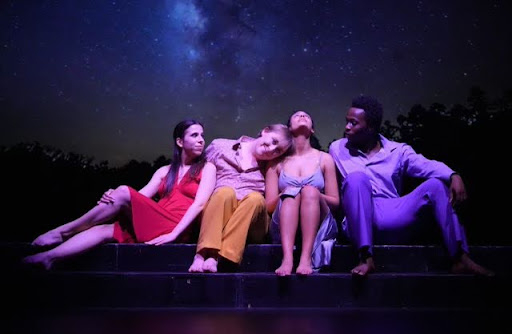Jules Bourbeau ’25
Managing Editor
Inspired by her ongoing research on the Gombey dance tradition in Bermuda, Visiting Scholar in Residence Dorothea Hast invited four members of the Warwick Gombey Troupe to perform and give a lecture titled “Call of the Drum: The Bermudian Gombey Tradition” at the Gruss Music Hall on Thursday March 21. The event was co-sponsored by The Center for Caribbean Studies, the Music Department, the Department of Theater and Dance, and the Community Learning Initiative. Irwin Trott is the troupe director and lead drummer, and was joined by bass drummer Alan Looby and dancers Khani Place and Omar Barnett.
After a brief introduction from Hast, the event exploded into color and sound almost immediately, as a sharp whistle and snapping drum beat urged the performers into the room. Their presence felt huge – literally, as the dancers gracefully ducked under the doorway to make room for their towering headdresses topped by brilliant peacock feathers. The troupe formed a whirlwind of dazzling tassels and shifting capes that soon stopped and stood at attention as abruptly as they had begun.
Gombey, as Trott explained, is an art form that takes influence from West African, Caribbean and Native American traditions. The dance dates back over 200 years, with one of its first mentions being a newspaper advertisement from the 19th century offering a bounty for two escaped enslaved Africans. According to the story, they are thought to have ran off with the Gombeys, never to be seen again. Indeed, the history of Gombey is deeply embedded in the history of slavery. The West Africans and Indigenous Americans (which are not, it must be noted, mutually exclusive identities) who were forcibly transported to Bermuda developed the dance as a means of resistance against British colonial forces. In fact, the full-body regalia of the dancers, including masks, was meant to help shield them against the legal persecution of those who openly practiced their culture.
Each part of the regalia serves a purpose or has a meaning. The masks are inspired by West African dance costumes, which often incorporate masks. The frills on the skirts and pants of the dancers originate from the grass skirts and cuffs worn by West African dancers, but are also reminiscent of clothes worn by Indigenous American performers such as the frilled fabric on the regalia worn for the Grass Dance. The capes and headdresses are handmade and decorated with intricate imagery that varies by dancer. Barnett was dressed in a rainbow of colors with a lighthouse motif, a map of Bermuda and a native bird, the white-tailed tropicbird. Place was covered in greens and blues, but Indian-inspired floral designs added a pop of gold to his ensemble.
After this lesson from Trott, the troupe danced once more. This was an artful combination of the three main types of Gombey dance: Freedom Dance (also called “Fast Dance”), Junkanoo (also spelled as “Jonkanoo” or “John Canoe”) and Masquerade.
Freedom Dance is characterized by its rapid movement and beat, and this rendition was performed by Place. Place is only 20 years old, but is already what Trott considers a “master dancer” This is because he has been dancing since he was two, and many Gombeys share a similar timeline. Most of them start around age three. Nevertheless, Trott emphasized that the tradition is “a journey for life.” He gave his own brother as an example, who is currently 63 years old and still dancing as a master.
Barnett performed Junkanoo, full of movements low to the ground and a drum beat that mimics the dancer’s footwork. He held a whip, which seemed to writhe with life as he worked through his steps. At one point, he cracked it over his head, producing a sound loud enough to rival the overpowering snare drum played by Trott.
Finally, both dancers joined together to perform the Masquerade. The two circled each other, pulling in closer and closer until they met, nearly touching. Kneeling on the ground, Place “fired” his bow and arrow at Barnett, winning the conquest. This section of the dance was a reenactment of the tale of David and Goliath. It is not uncommon for Masquerade dances to be based on Biblical stories, since the British colonists brought Christianity to Bermuda. The Gombeys turn this historical imposition into a moment of power, choosing to place themselves at the center of stories of resistance and triumph over seemingly insurmountable odds.
After the three-part performance, Trott turned to a discussion of how the history of Gombey and Bermuda is still being discovered today. For centuries, the residents of Bermuda knew that they and many of their community members had ties to Native American groups in the mainland United States. However, mistaken British colonizers had described them as “Mohawks,” an Iroquioan group. Through archival research conducted in the early 2000s, Trott and others discovered that it was actually Pequot (an Algonquian people based in modern-day Connecticut) people whom the colonizers sent to Bermuda. In celebration of their newfound connection, the Warwick Gombey Troupe performed at Schemitzun, an annual Mashantucket Pequot celebration. In turn, several Pequot tribal members traveled to Bermuda. The connection between the two groups remains to this day.
Before closing out, Trott invited several audience members forward to learn some simple Gombey steps of their own. Place and Barnett guided them with the help of Looby’s drumming, providing what Trott called “the heartbeat of the rhythm.”
After the newly-initiated dancers returned to their seats, Trott emphasized that Gombey is, above all else, “a people’s culture.” Every Boxing Day, among other holidays, the Gombeys will dance and drum through the streets of Bermuda for as much as twelve hours straight with a crowd of impassioned people behind them. “We truly get tired,” Trott admitted. “But what gives us our energy? The audience.” While Gombey troupes may sometimes perform for tourists or corporate groups, as a uniquely Bermudian tradition, Trott concluded that, “At the end of the day, it’s for our people.”









[…] story said, “Inspired by her ongoing research on the Gombey dance tradition in Bermuda, Visiting Scholar […]